STOLPERSTEINE GELSENKIRCHEN
Ausgrenzung erinnern

|
HERE LIVED
 SALOMON TEPPER SALOMON TEPPER
BORN 1893
ADMITTED 6.2.1942
JACOBY'SCHE ANSTALT
BENDORF-SAYN
DEPORTED 1942
IZBICA
FATE UNKNOWN
|
HERE LIVED
 SARA TEPPER SARA TEPPER
NEE STEUER
BORN 1898
DEPORTED 1942
RIGA
MURDERED NOV. 1943
|
|
HERE LIVED
 ANNA TEPPER ANNA TEPPER
BORN 1923
FLUCHT 1939
HOLLAND
INTERNED WESTERBORK
DEPORTED 1943
SOBIBOR
MURDERED 4.6.1943
|
HERE LIVED
 DORA TEPPER DORA TEPPER
BORN 1924
FLUCHT 1939
HOLLAND
INTERNED WESTERBORK
DEPORTED 1942
AUSCHWITZ
MURDERED 15.12.1942
|
HERE LIVED
 MAX TEPPER MAX TEPPER
BORN 1926
FLEED 1939
HOLLAND
HIDDEN/SURVIVED
|
Stumbling Stones installed at: Florastraße/Höhe Kennedyplatz (formerly: Schalker Street 45)
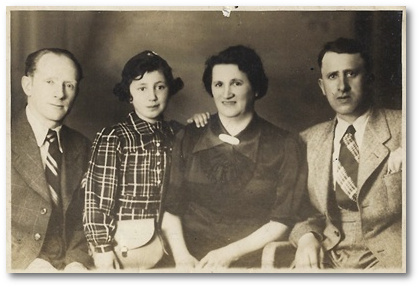
Fig. 1: From left to right: Salomon Tepper, Hanna Ramer, Sara Tepper and Leib Steuer. Hanna Ramer, who went to England on a kindertransport, was the only survivor. (To enlarge click on picture)
Salomon Tepper was born in Szufnarowa on 15 June 1893. He was married to Sara Tepper, née Steuer, who was born in Dzwienanz on 18 July 1898. The couple had three children, all born in Gelsenkirchen, Anna born on 28 January 1923, Dora born on 16 March 1924 and Max, born on 1 August 1926.
|
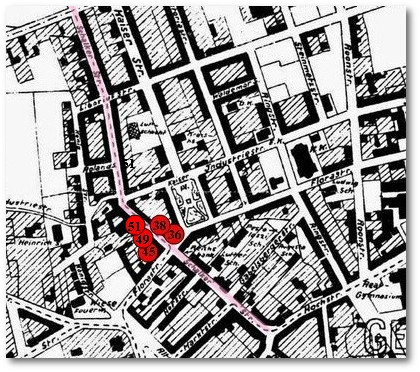
Ill.: Schalker Strasse in the past, location of house numbers 36, 38, 45, 49 and 51, according to land registry records. From around the end of 1939, house numbers 36, 38, 49 and 51 were declared so-called “Judenhäuser”, Jewish houses. Jews were forced to live here and in buildings in other parts of town; it made it easier for the Gestapo to control these small-scale ghettos. In the early fifties this area was redesigned and is now called Kennedy-Platz and Elisabeth-Nettebeck-Platz.
In the early thirties the Tepper family first lived at Bismakrckstrasse 78. According to records, the last address they chose to live at was Schalker Strasse 45. At the end of the thirties the Nazis also forced the Jewish Tepper family to move to one of the so-called Jewish houses in Gelsenkirchen at Schalker Strasse 38.
|
The lists made by Gelsenkirchen’s Jewish community in 1946, show that in December 1941 Salomon Tepper was admitted to the “Heil und Pflegeanstalt der Reichsvereinigung der Juden in Bendorf-Sayn” (Jacoby’sche Anstalt in Bendorf-Sayn). The register shows the entry “6.2.1942 near Bendorf/Rhineland camp Hindenburg Stasse 49”.
Ill. 2. Salomon Tepper family, Gelsenkirchen registration records (Click to enlarge documents)
From 1940 the Ministry of Internal Affairs ordered that all Jewish patients at “clinics and mental institutions” of the German Reich should be put together at Bendorf-Sayn. The reason: “Jews and Germans” were no longer to be accommodated in the same place.
There were far too many patients at the “Israelitische Heil- und Pflegeanstalt” (Jewish clinic and mental institution) in Bendorf-Sayn and conditions were terrible; there was a lack of medicine and food. The “euthanasia programme” was “officially” stopped in 1941 and from 1942 Jewish patients at Bendorf-Sayn were deported to the extermination camps in occupied eastern Europe where they were murdered. The Gestapo list of “Jews from the district of Koblenz who were deported on 30 April 1942” (1) included Salomon Tepper. The Jews on the transport of 30 April 1942 from Koblenz-Lützel were deported to the Krasniczyn ghetto in the district of Lublin in the so-called “Generalgouvernement”.
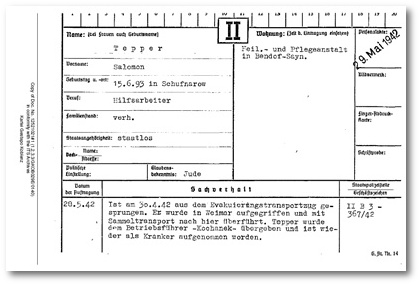 Ill. 3. Note of the Gestapo Koblenz, source: ITS, Arolsen (click picture to enlarge)
Salomon Tepper managed to escape from the train but he was arrested and taken back to Bendorf-Sayn.
In the Koblenz Gestapo records of 28 May 1942 it says: on 30 April 1942 Salomon Tepper (…) jumped from the evacuation transport train. He was found in Weimar and taken here on a collective transport. Tepper was taken to the operations manager, Mr Kochanek and readmitted as a patient. (2)
A short time later he was deported again. Salomon Tepper is included in a list produced by the Gestapo-State Police office in Koblenz on 7 July 1942 “of the Jews deported (3) from Bendorf-Sayn Heil- und Pflegeanstalt on 15 June 1942.
Ill. 4 & 5: Telegram from the Reichssicherheitshauptamt (RSHA - Central Office for the Security of the Reich) Adolf Eichmann to the Düsseldorf Gestapo: The special train abbreviated to “Da 22” was bound for Izbica near Lublin,
source: ITS, Arolsen. (click documents to enlarge)
From 1942 Izbica was a transit ghetto for Jews being deported to the Nazi extermination camps, particularly to Belzec and Sobibór. No more is known about Salomon Tepper.
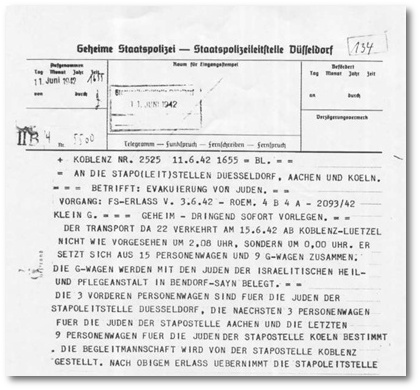 Ill.: Letter of 11 June 1942 from the RSHA to the Gestapo in Düsseldorf (click picture to enlarge)
Another telegram of 11 June 1942 from the “Eichmann department” (IVb 4A) at the RSHA, informs the Gestapo office of organisational details of the deportation. 9 freight wagons are planned for the transport of people from the “Jewish clinic and psychiatric institution in Bendorf-Sayn”.
On 27 January 1942 Salomon Tepper’s wife Sara was deported from Gelsenkirchen to Riga. She was murdered in November 1943 in the liquidation of the Riga Ghetto.
|
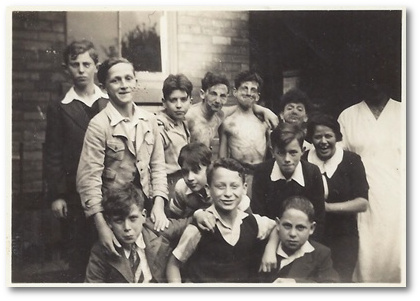 Fig. 6: On the left in a light-coloured jacket, standing: Max Tepper. The photo was probably taken at the Jewish school on Ring Strasse in Gelsenkirchen. Who can help identify the people in the photo?  Email (To enlarge, click picture) Email (To enlarge, click picture)
According to records, on 22 February 1939 the children Anna, Dora and Max were able to flee from Gelsenkirchen to the Netherlands. Dora Tepper worked as a maid in Amsterdam; for some time she lived at the orphanage for girls (Nederlands-Israelitisch Meisjesweeshuis) on Rapenburgerstraat 171.
|
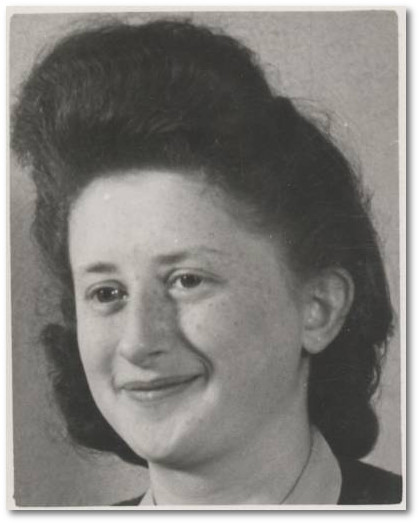
|
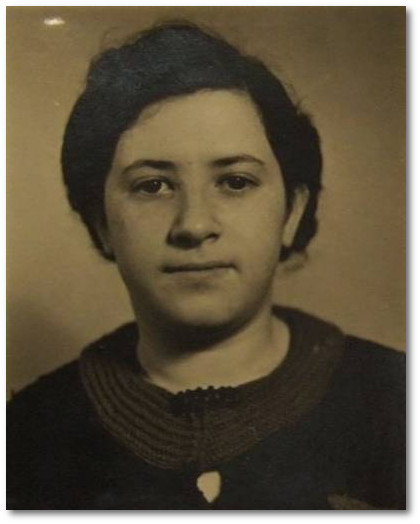
|
Shortly after the Germans invaded the Netherlands in May 1940, the girls were captured by the Nazis. On 3 December 1942 Dora Tepper was deported to the “polizeiliche Judendurchgangslager Kamp Westerbork” (the official name given by the Nazis from 1 July 1942). On 12 December 1942 she was deported to Auschwitz and murdered there on 15 December 1942. On 1 June 1943 Anna was deported from Westerbork to Sobibor extermination camp where she was murdered on 4 June 1943.
Ill. 7: Dora Tepper (le.). She perished at the young age of 18, her Sister Anna (ri.)was 20 years old when she was murdered
|
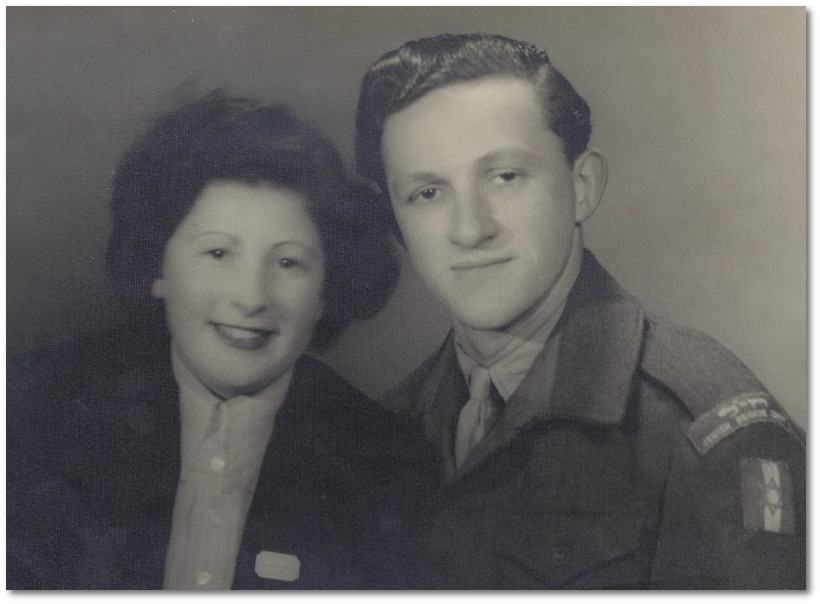
Ill.8: Anne Steuer und Max Tepper
Max Tepper survived the Holocaust while he could be rescued on April 17, 1939 with a Kindertransport to England. He joined the British Army’s Jewish Brigade and later emigrated to the USA.
The stumbling stones in memory of the Tepper family have been sponsored by the Inner Wheel Club; Dr. Ulrike Asche-Zeit is also a sponsor.
References:
db.yadvashem.org
search.ancestry.com
www.jewishgen.org
Electoral list of 15 November 1930 for the foundation of the liberal Jewish Synagogue Community, StA GE 0 XXII 10 1
Memorial book, German federal Archives
Lists of the Jewish Community regarding deportations in: Andrea Niewerth, Gelsenkirchener Juden im NS, 2002
[1] Copy of Doc. No. 11196885#2 (1.2.1.1/0001-0060/0014/0039) in conformity with the ITS Archives, Transportlisten Gestapo
[2] Copy of Doc. No. 12521021#1 (1.2.3.3/GKOB029E/0140)in conformity with the ITS Archives, Kartei Gestapo Koblenz
[3] Copy of Doc. No. 11196890#1 (1.2.1.1/0001-0060/0014/0044) in conformity with the ITS Archives, Transportlisten Gestapo
[4] Copy of Doc. No. 82164666#2 (1.2.3.0/0004/0131)in conformity with the ITS Archives, Akten der Gestapo und Informationen über die Gestapo
Illustrations:
Ill.: 1,5, 8 Private property of the family, with courtesy of the descendants/Chava Moskovitz
Ill.: 2 Registration records, StA Gelsenkirchen/ISG
Ill.: 3 (Doc. ID 12521021) und 4+5 (Doc. ID 82164666): ITS, Arolsen
Ill.: 7 Dora Depper: Joods NL, Collectie Joods Historisch Museum, Anna Tepper: dokin - Stichting Duitse Oorlogskinderen in Nederland
Andreas Jordan, Projektgruppe STOLPERSTEINE Gelsenkirchen. August 2011. Supplement November 2012
Stumbling Stones in memory of the Tepper Family, installed April 29, 2013
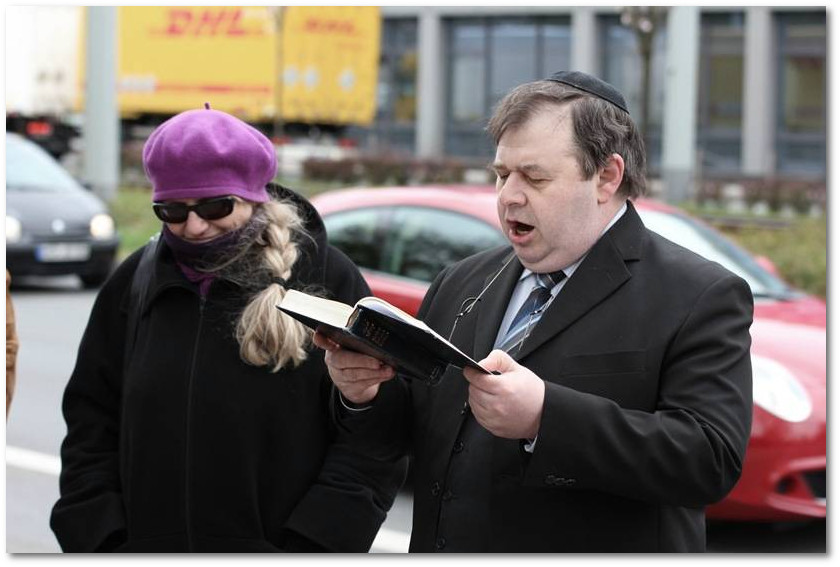
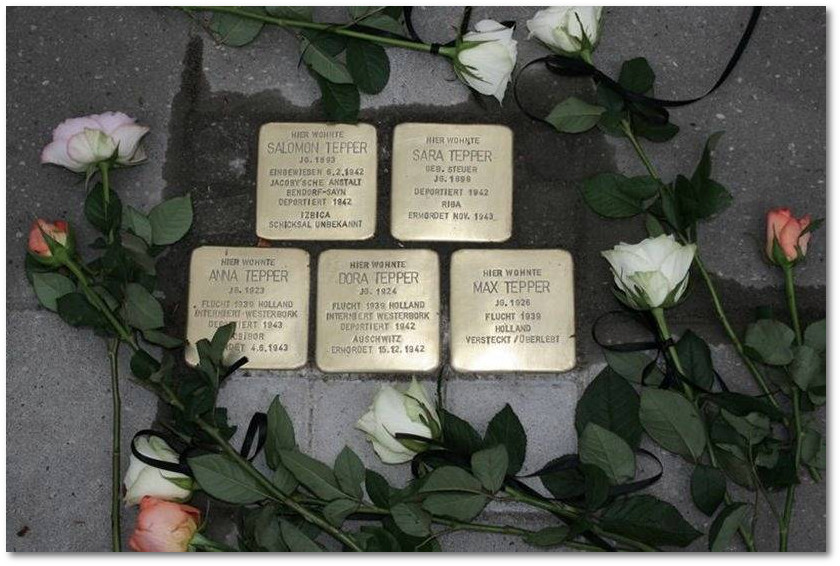
|